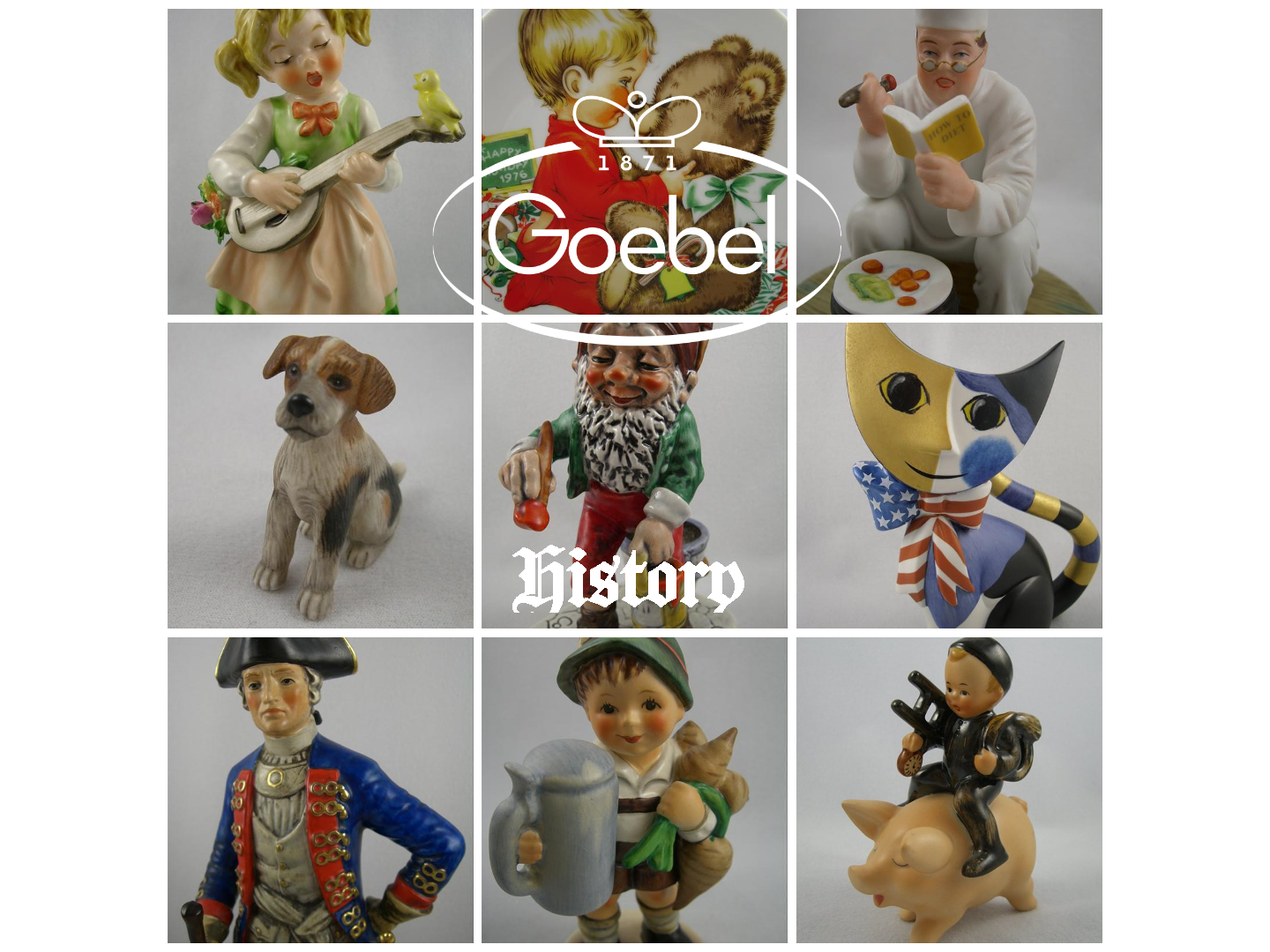Introduction
The Goebel Company, based in Rödental, northern Bavaria, has been creating fine porcelain tableware and decorative items since 1871. Most famous for producing M.I. Hummel decorative pieces, in particular handcrafted figurines, Goebel’s offerings also
History
The company of F&W Goebel was founded in January 1871 by Franz Detleff Goebel, a porcelain merchant, and his son William. It was not until 1879, with the permission of the Duke of Coburg, that they fired up their first kiln, however. Until then, the Goebels produced slates, slate pencils and children’s marbles. In 1876, the first building was erected beneath Coburg Castle on the outskirts of what was then the town of Oeslau, in central Germany´s porcelain-producing region and close to the legendary Kipfendorf clay deposits. Oeslau is today part of Rödental, named after the river Röden.
The porcelain works of F&W Goebel began producing porcelain dinnerware pieces and by 1900 was one of the largest firms in the region, with approximately 400 employees. Franz was beginning to defer more and more of the artistic direction to William, who was looking for ways to further grow the business and expand the product lines. Under William’s direction, the company name was changed to W.Goebel Porzellanfabrik and output was expanded to include figurines, dolls, lamps, candy dishes, and vases. In 1909, William sent his 16-year-old son, Max Louis, to America, seeing this as an important future market for the firm.
In 1911, after spending time working for Marshall Fields and other big US firms, Max Louis Goebel returned to Germany to help bring the company into the 20th century. Max built his own factory near Kronach, but closed it down later the same year, when his father passed away, to assume control of the company.
Upon inheriting the family firm, Max Louis Goebel had already learned much about the U.S. market and the fast-paced American style of doing business. With his artistic flair and progressive attitude, he succeeded in expanding the market for his products at home and abroad. He increased the number of master sculptors, attracting some of Europe's finest sculptors to Goebel's studios, managing to step up production without sacrificing quality.
With an understanding of the changing tastes and fashions of the day, Max Louis established relationships with a variety of contemporary artists and purchased a selection of their artwork as the basis of decorative figurines- a practice the company maintains to this day. His innovation led to a huge number of new products and also to new technologies that, in 1926, produced the fine-grained earthenware that was to set the stage for their most popular range of figurines, M.I. Hummel.
In 1929, W. Goebel Porzellanfabrik suffered a double-whammy. Sadly, Max Louis died this year, after 18 years in control. Later that year the US stock market crash also impacted the company, as it did most businesses around the world. However, Max Louis had built a sound business with good distribution channels and now in the competent hands of his son Franz Goebel, and son-in-law Dr. Eugen Stocke, the company quickly bounced back from the events of this year. Franz and Eugen were both aware that continued innovation was the key to survival in the post-crash depression.
In the early 1930s the artwork of a Franciscan Sister, Maria Innocentia Hummel, came to the attention of Franz Goebel. Her images of childhood innocence were just what Franz was looking for to help customers escape the realities of political turmoil and difficult times. After securing an exclusive agreement to produce figurines based on her artwork, 1935 saw the first issues of what would become the company’s most successful series of products. The full history of M.I.Hummel figurines is covered in our Hummel History section.
During WWII, the ruling German National Socialist party placed restrictions on exports. Domestic production was focused on military needs and only certain exports were allowed for purposes of earning foreign currency. Goebel was only permitted to export M.I. Hummel figurines during the war years.
Once the war was over, Goebel enjoyed remarkable expansion and evolution. Their figurines were sought after domestically by German families trying to rebuild their lives and homes and were also more in demand from Americans that had become aware of the brand while stationed in Germany. The increased demand allowed for the modernization of the Goebel factory, updating of kilns and improvement of techniques, while still maintaining the fundamental company traditions of handcrafting and hand painting.
Continually seeking new products and partnerships, the 1950s saw Goebel experiment with the production of a small line of toys. This ultimately led to the opening of a new factory in 1967 specifically focused on the production of toys. In 1952, Franz Goebel, looking to capitalize on America’s growing fascination with movies and TV, met with Walt Disney, resulting in a successful line of figurines and collectibles based on the Disney animations and characters.
Goebel continued its expansion through the 1960s, setting up a sales organization in the United States in 1968 (Goebel of North America). The next year saw the death of Franz Goebel and the company passed to the family’s fifth generation, in the form of Wilhelm Goebel, along with Eugen and Ulrich Stocke.
In the company’s centennial year (1971), the popularity of Goebel products, especially the M.I. Hummel figurines, continued to surge. In 1977, the Goebel's Collectors Club was formed, the first organization of its kind in the industry. This was renamed in 1989 to the M.I. Hummel Club, reflecting the overwhelming level of attention the M.I.Hummel figurines were attracting. The original intent of the collectors club was an information service, but with over 100,000 members joining in the first year, it soon became an important channel for the company’s promotional and marketing efforts.
Products
It is impossible to recount the history and progression of the Goebel empire without considerable emphasis on the range of M.I.Hummel products, which have become so immensely popular the world over. However, to focus exclusively on these wonderful and undeniably important figurines would be unfair to the many other ranges of quality, sought-after collectibles. The following less well-known figurines and giftware items are also part of the Goebel archive:
Charlot Byj, born in Pennsylvania in 1920 of Polish parents, was the artist behind 2 popular ranges of figurines by Goebel. Her most famous contribution is the “Red Heads” series of children, featuring over 100 different figurines. A blonde series features another 16 figurines. Franz Goebel, the 4th generation head of Goebel, noticed Charlot’s artwork on greeting cards by published by Ars Sacra and invited her to visit his production facility. Goebel produced her characters from 1957 until 1988, mainly as figurines.
“Co-Boy” figurines are another popular series of figurines made by the Goebel Company. These figurines feature small elf or gnome-like characters. Their name comes from their town of origin, Coburg, and each figure represents a town resident or profession (e.g. cooks, chefs, firemen, butchers, doctors, divers, etc.). There are more than 60 figurines in this collection, which was manufactured between 1971 and 1987.
Blumenkinder (German for “Flower Children”) is a series of figurines based on the artwork of Bavarian artist, Lore. There were more than 50 of these highly detailed figurines produced by Goebel between 1966 and 1982. They depicted boys and girls experiencing common events, such as first dates, and usually feature intricate flowers. Most of these were produced in limited editions of 2000.
Other popular lines from Goebel include:
- The Friar Tuck and Red Cardinal line of brown- and red-robed monks.
- Dolly Dingle figurines, designed by Grace Drayton, featuring Dolly Dingle and her friend, dressed in costumes of Holland, Italy, Spain, Germany, Scotland and more.
- The DeGrazia figurines, designed by Ted DeGrazia, based on Apache, Navaho, and Hopi Indians. There are 17 different figurines in this series.
- Beauty Around the World, featuring pretty ladies dressed in native costumes. This series was limited to 12.
- Fashions on Parade, another pretty ladies series featuring 23 different ladies.
- A series of at least 12 Normal Rockwell figurines.
- Collections of the Masters, based on Richard Simmons’ personal collection of one-of-a-kind dolls.
- The Whimsical World of Pocket Dragons, created by fantasy artist Real Musgrave
- Artis Orbis (the world’s art), a collection of beautiful lifestyle home décor accessories that features artwork of famous artists such as Leonardo Da Vinci, Pierre-Auguste Renoir, Vincent van Gogh and Claude Monet.
© 2007 Woolvey LLC


